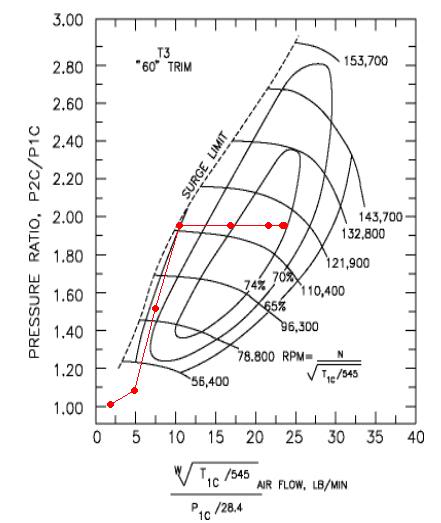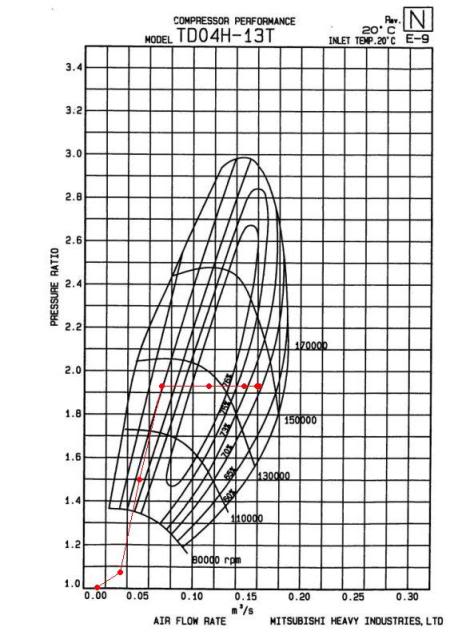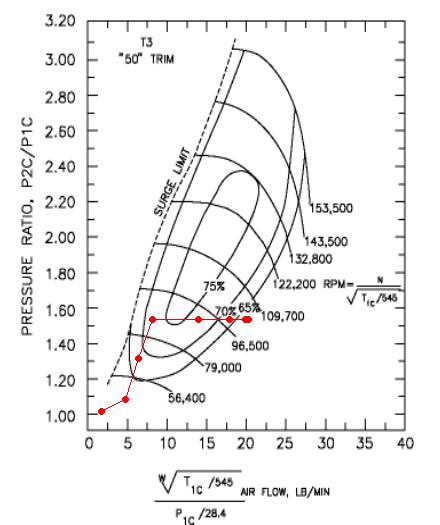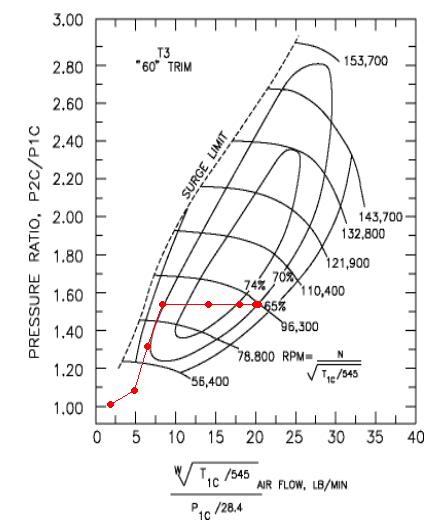Turbo Application Calculations
#1
If you're a mechanical engineering geek, this post is for you! 
Iím posting this here for everyone to learn from. If youíve ever wanted to learn how to properly size a turbo for your application and youíre too lazy to Google it, lol, hereís how itís done.
Iíve been having difficulties calculating for my own application so Iím posting it up here for everyone to see in the hopes that someone will be able to help point out where Iíve made an error, if any. Something isnít adding up and doesnít make sense.
I know for a fact the T3 60trim turbo we had on the MR2 (1.6L) was too big for the application. At 10-15psi boost at 7500rpm, it was right in the meat of its efficiency range. Yet, when I calculate for my Hondaís 1.6L (same size engine), itís outside the range (choke line) on the compressor map and shows the turbo is actually too small, even though I know it was on the large side for this size engine.
So Iím going to show all my math with several formulas showing how I calculated for engine volume flow (EVF) and air flow in lbs/min at X amount of boost and how these values, when plotted on the compressor map show the turbo is too small, which to me does not make sense. Hopefully someone will be able to see where Iíve gone wrong.
Here goes:
Basic info: Honda b16a2, 1.6L 4 cylinder. Iím looking for a mild, reliable street setup. Power goal is about 200hp at the flywheel.
A quick way to effectively calculate how much flow your engine will need to make the power you want to produce is to use this formula,
Flow in lbs/min= target hp x AFR x BSFC/60
AFR = Target air/fuel ratio (13 is a good safe AFR value for most lower-boost applications for higher than 10psi boost, Iíd re-calculate using 12.5). BSFC is brake specific fuel consumption. A good approximate for this value for most engines is 0.55.
So now we have:
=200x13x0.55/60
=23.4lbs/min
So Iíll need my engine to flow 23.4lbs of air per minute to make 200hp at the flywheel. It is interesting to note that with this calculation it shows that regardless of the engine size/rpm, there is a set amount of air any given engine is required to flow to produce 200hp. This is why a 3.0L v6 engine can easily make 200hp and a 4 cylinder with half the displacement needs to rev much higher or requires a turbo to help the engine flow the same amount of air. It's all mathematical.
Next Iíll calculate the engineís volume flow at atmospheric pressure (14.7 psia or 0 psig)
Engine Volume Flow,
EVF= (engine CID/1728)x(rpm/2)
=(97.638/1728)x(8000/2)
=0.0565034 x 4000
EVF=226cfm
So it flows 226 cubic feet of air per minute at 8000rpm at atmospheric pressure (0psi boost).
Next Iíll calculate engine flow in lbs/min at 7psi boost at 8000rpm. On a side note, the reason I calculate flow at 8000rpm is because I want to know the maximum amount of air the engine will require so I can properly choose a turbo that can provide enough flow at the boost level required.
So engine flow in lbs/min (N), (P=pressure (boost pressure + atmospheric pressure), (T= temp in rankine). Other numbers are constants.
N=PxEVFx29/10.73xT
=21.7x226x29/10.73x527.67
=25lbs/min.
At 7psi boost, the engine will be flowing 25lbs/min of air at 8000rpm. Given that 23.4lbs/min is required to make 200hp, 7psi boost will be a perfect amount to meet my power goal. Depending on your power goal, you can use this formula and re-arrange it to calculate exactly how much boost your engine will need to match the required volume flow calculated based on your power goal. I just guessed at 7psi boost and came out lucky...lol.
So far I havenít accounted for volumetric efficiency or VE. Most engines are around 85-95% VE in NA applications. Itís not impossible for some engines to have 100% or slightly above, NA. In some of my research Iíve read that some d-series and b-series Honda engines were around 100-108% VE.
To calculate the VE of my engine I used the following formula,
VE=(HPx792001.6)/(Atmospheric pressure x Compression ratio x Cubic inches displacement x rpm)
=(200 x 792001.6)/(14.7x10.5x97.638x8000)
=1.31 or 131% VE
In other words, for a 1.6L to make 200hp at 8000rpm the engine will have a VE of 131%. Cool stuff.
Onto compressor mapsÖ. Take a look at the following compressor map for a T3 60 trim Garrett turbo.

Along the bottom or x-axis is engine flow in lb/min. I calculated earlier that at 7psi my engine would be flowing 25lb/min at 8000rpm. Up the side of the map or y-axis is the pressure ratio, which is simply total pressure (boost pressure + atmospheric pressure)/atmospheric pressure. At 7 psi the pressure ratio = 1.476 or roughly 1.5. Now if we draw a line straight up from 25lb/min from the x-axis and another line straight across from 1.5 on the y-axis, where these two line intersect shows you if that turbo will be able to efficiently provide enough air flow. In this example, itís just off the chart on the choke line, meaning the turbo cannot keep up with the flow requirements.
This confuses me and is why I posted this up. If this turbo was too big for a 1.6L and was just entering the meat of its efficiency range at ~13psi at 7500rpm, why do my calculations not show the lines for air flow and pressure ratio intersecting more towards the center of the efficiency ďblobĒ on the map? Iíve also tried calculating for 15psi boost and itís the same thing, only higher up the choke side (right hand side) of the map, but still off or on the very edge of the mapÖ Something doesnít make sense. Maybe thereís something Iíve forgotten or something Iím not seeing?
Hopefully someone with a fresh mind and fresh eyes might see where Iíve gone offÖ I know there are some knowledgeable people on this board with regards to turbo charging, so I'm hoping someone can help me figure this out.
Thanks for reading.
Mike.

Iím posting this here for everyone to learn from. If youíve ever wanted to learn how to properly size a turbo for your application and youíre too lazy to Google it, lol, hereís how itís done.
Iíve been having difficulties calculating for my own application so Iím posting it up here for everyone to see in the hopes that someone will be able to help point out where Iíve made an error, if any. Something isnít adding up and doesnít make sense.
I know for a fact the T3 60trim turbo we had on the MR2 (1.6L) was too big for the application. At 10-15psi boost at 7500rpm, it was right in the meat of its efficiency range. Yet, when I calculate for my Hondaís 1.6L (same size engine), itís outside the range (choke line) on the compressor map and shows the turbo is actually too small, even though I know it was on the large side for this size engine.
So Iím going to show all my math with several formulas showing how I calculated for engine volume flow (EVF) and air flow in lbs/min at X amount of boost and how these values, when plotted on the compressor map show the turbo is too small, which to me does not make sense. Hopefully someone will be able to see where Iíve gone wrong.
Here goes:
Basic info: Honda b16a2, 1.6L 4 cylinder. Iím looking for a mild, reliable street setup. Power goal is about 200hp at the flywheel.
A quick way to effectively calculate how much flow your engine will need to make the power you want to produce is to use this formula,
Flow in lbs/min= target hp x AFR x BSFC/60
AFR = Target air/fuel ratio (13 is a good safe AFR value for most lower-boost applications for higher than 10psi boost, Iíd re-calculate using 12.5). BSFC is brake specific fuel consumption. A good approximate for this value for most engines is 0.55.
So now we have:
=200x13x0.55/60
=23.4lbs/min
So Iíll need my engine to flow 23.4lbs of air per minute to make 200hp at the flywheel. It is interesting to note that with this calculation it shows that regardless of the engine size/rpm, there is a set amount of air any given engine is required to flow to produce 200hp. This is why a 3.0L v6 engine can easily make 200hp and a 4 cylinder with half the displacement needs to rev much higher or requires a turbo to help the engine flow the same amount of air. It's all mathematical.
Next Iíll calculate the engineís volume flow at atmospheric pressure (14.7 psia or 0 psig)
Engine Volume Flow,
EVF= (engine CID/1728)x(rpm/2)
=(97.638/1728)x(8000/2)
=0.0565034 x 4000
EVF=226cfm
So it flows 226 cubic feet of air per minute at 8000rpm at atmospheric pressure (0psi boost).
Next Iíll calculate engine flow in lbs/min at 7psi boost at 8000rpm. On a side note, the reason I calculate flow at 8000rpm is because I want to know the maximum amount of air the engine will require so I can properly choose a turbo that can provide enough flow at the boost level required.
So engine flow in lbs/min (N), (P=pressure (boost pressure + atmospheric pressure), (T= temp in rankine). Other numbers are constants.
N=PxEVFx29/10.73xT
=21.7x226x29/10.73x527.67
=25lbs/min.
At 7psi boost, the engine will be flowing 25lbs/min of air at 8000rpm. Given that 23.4lbs/min is required to make 200hp, 7psi boost will be a perfect amount to meet my power goal. Depending on your power goal, you can use this formula and re-arrange it to calculate exactly how much boost your engine will need to match the required volume flow calculated based on your power goal. I just guessed at 7psi boost and came out lucky...lol.
So far I havenít accounted for volumetric efficiency or VE. Most engines are around 85-95% VE in NA applications. Itís not impossible for some engines to have 100% or slightly above, NA. In some of my research Iíve read that some d-series and b-series Honda engines were around 100-108% VE.
To calculate the VE of my engine I used the following formula,
VE=(HPx792001.6)/(Atmospheric pressure x Compression ratio x Cubic inches displacement x rpm)
=(200 x 792001.6)/(14.7x10.5x97.638x8000)
=1.31 or 131% VE
In other words, for a 1.6L to make 200hp at 8000rpm the engine will have a VE of 131%. Cool stuff.
Onto compressor mapsÖ. Take a look at the following compressor map for a T3 60 trim Garrett turbo.

Along the bottom or x-axis is engine flow in lb/min. I calculated earlier that at 7psi my engine would be flowing 25lb/min at 8000rpm. Up the side of the map or y-axis is the pressure ratio, which is simply total pressure (boost pressure + atmospheric pressure)/atmospheric pressure. At 7 psi the pressure ratio = 1.476 or roughly 1.5. Now if we draw a line straight up from 25lb/min from the x-axis and another line straight across from 1.5 on the y-axis, where these two line intersect shows you if that turbo will be able to efficiently provide enough air flow. In this example, itís just off the chart on the choke line, meaning the turbo cannot keep up with the flow requirements.
This confuses me and is why I posted this up. If this turbo was too big for a 1.6L and was just entering the meat of its efficiency range at ~13psi at 7500rpm, why do my calculations not show the lines for air flow and pressure ratio intersecting more towards the center of the efficiency ďblobĒ on the map? Iíve also tried calculating for 15psi boost and itís the same thing, only higher up the choke side (right hand side) of the map, but still off or on the very edge of the mapÖ Something doesnít make sense. Maybe thereís something Iíve forgotten or something Iím not seeing?
Hopefully someone with a fresh mind and fresh eyes might see where Iíve gone offÖ I know there are some knowledgeable people on this board with regards to turbo charging, so I'm hoping someone can help me figure this out.
Thanks for reading.
Mike.
#5
^That's what quick tax is for! 
I hoping once I get this figured out, I'll make a new thread and either scrap this thread or archive it/link to it for extra info. The new thread will cover everything in order and will be much more organized, detailed and easier to follow. lol.

I hoping once I get this figured out, I'll make a new thread and either scrap this thread or archive it/link to it for extra info. The new thread will cover everything in order and will be much more organized, detailed and easier to follow. lol.
#6
Alrighty, well was talking with a friend of mine this evening (guy who owns our MR2 turbo) and we were talking about turbo setups/calculations etc.
We came to the conclusion that my calculations are fine, but there is some factor(s) I'm not accounting for somewhere...
He pointed me in the direction of this website Squirrel Performance where he found his calculations he did for the MR2 matched the results fairly closely. This website has a fairly accurate turbo calculator. You input your data and it extrapolates the air flow and maps it on the compressor map of whatever turbo you're thinking of running to see how well matched it will be. The predictions this calculator makes are quite good, I can account for that. They match quite well to the actual performance of each of these turbos we've have on the MR2.
So, all that being said, here's a look at the MR2 with the old 60trim T3:

This is with approx. 13.6psi boost producing about 240hp.
You can see at roughly 5000rpm (5th point), it was just starting to get into the peak efficiency range of this turbo. Not so useful in autocross when we spend 90% of the time between 3000 and 6000rpm...lol. A good dyno queen turbo for this motor, but not practical for the street or autocross.
That prompted us to swap it out for the stock turbo from an impreza WRX. The smaller TD04-13T:

This is also with 13.6psi and producing about 240hp.
Major difference here, you can see at 3000rpm (4th point) it's already at 70% efficiency and climbing rapidly. Max boost builds at about 3000rpm and holds strong all the way to the 7500rpm rev limit and is capable of even more... Much better for autocross!
Now here's my B16 with the T3-50 trim I just picked up the other day. Power goal is 200hp and it estimated about 7.7psi boost would be required (got that right in my calculations, lol):

Here you can see it wouldn't be able to provide enough volume flow in the high rpm range, falling off fast above 6000rpm. At this point the turbo is more of a restriction and heat pump than anything else...lol.
This turbo would actually make a pretty good street setup for a lower-revving d-series... Especially the smaller D15's...
Last but not least, the B16 with the old T3-60 trim we first used on the MR2:

Definitely a better match than the 50 trim, boost would start building strong between 3-4000rpm (70% efficiency at 3000rpm (4th point)) and much more of this turbo's peak efficiency range could be utilized by the higher-revving ability of the b16. I think this is the best turbo I've found so far to match the B16 (that I have on hand), based on my power goals. I did plot the B16 on the TD04-13T but didn't save the map. It's an even better match, but not the easiest turbo to get your hands on...
Anyways, if you wan to see which turbo would be best suited for your specific engine and power goals, visit the squirrel performance web site, plug in you're values and try selecting various types of turbos to see which one would be best.
I'm not really sure if anyone else cares that much about all this, but I'm posting this info anyways because I find it very interesting and I'm sure there are people out there, like me, who are looking for this kind of stuff and have a hard time finding it. So there it is. lol.
Thanks for reading.
We came to the conclusion that my calculations are fine, but there is some factor(s) I'm not accounting for somewhere...
He pointed me in the direction of this website Squirrel Performance where he found his calculations he did for the MR2 matched the results fairly closely. This website has a fairly accurate turbo calculator. You input your data and it extrapolates the air flow and maps it on the compressor map of whatever turbo you're thinking of running to see how well matched it will be. The predictions this calculator makes are quite good, I can account for that. They match quite well to the actual performance of each of these turbos we've have on the MR2.
So, all that being said, here's a look at the MR2 with the old 60trim T3:

This is with approx. 13.6psi boost producing about 240hp.
You can see at roughly 5000rpm (5th point), it was just starting to get into the peak efficiency range of this turbo. Not so useful in autocross when we spend 90% of the time between 3000 and 6000rpm...lol. A good dyno queen turbo for this motor, but not practical for the street or autocross.
That prompted us to swap it out for the stock turbo from an impreza WRX. The smaller TD04-13T:

This is also with 13.6psi and producing about 240hp.
Major difference here, you can see at 3000rpm (4th point) it's already at 70% efficiency and climbing rapidly. Max boost builds at about 3000rpm and holds strong all the way to the 7500rpm rev limit and is capable of even more... Much better for autocross!

Now here's my B16 with the T3-50 trim I just picked up the other day. Power goal is 200hp and it estimated about 7.7psi boost would be required (got that right in my calculations, lol):

Here you can see it wouldn't be able to provide enough volume flow in the high rpm range, falling off fast above 6000rpm. At this point the turbo is more of a restriction and heat pump than anything else...lol.
This turbo would actually make a pretty good street setup for a lower-revving d-series... Especially the smaller D15's...

Last but not least, the B16 with the old T3-60 trim we first used on the MR2:

Definitely a better match than the 50 trim, boost would start building strong between 3-4000rpm (70% efficiency at 3000rpm (4th point)) and much more of this turbo's peak efficiency range could be utilized by the higher-revving ability of the b16. I think this is the best turbo I've found so far to match the B16 (that I have on hand), based on my power goals. I did plot the B16 on the TD04-13T but didn't save the map. It's an even better match, but not the easiest turbo to get your hands on...
Anyways, if you wan to see which turbo would be best suited for your specific engine and power goals, visit the squirrel performance web site, plug in you're values and try selecting various types of turbos to see which one would be best.
I'm not really sure if anyone else cares that much about all this, but I'm posting this info anyways because I find it very interesting and I'm sure there are people out there, like me, who are looking for this kind of stuff and have a hard time finding it. So there it is. lol.
Thanks for reading.










